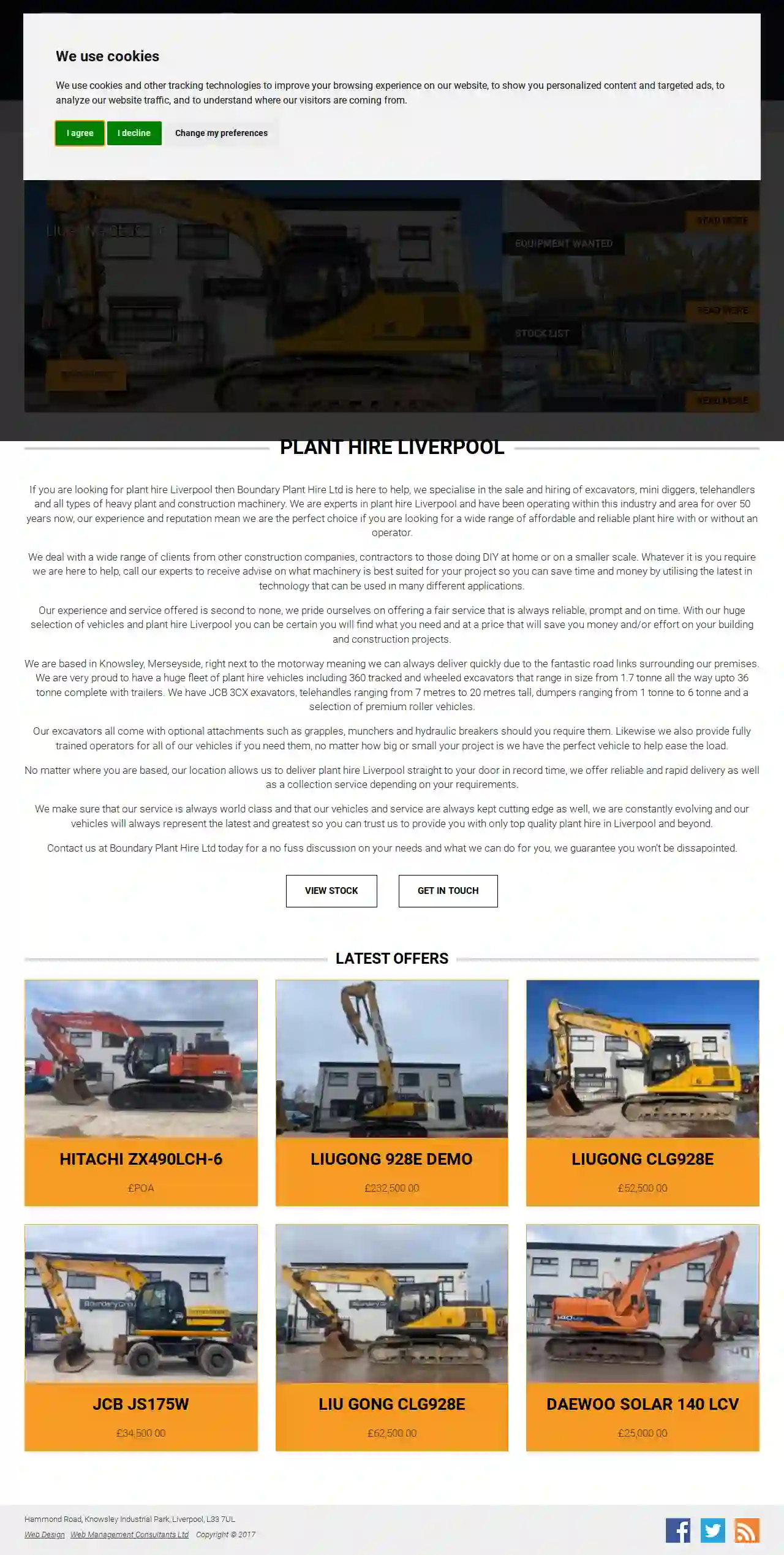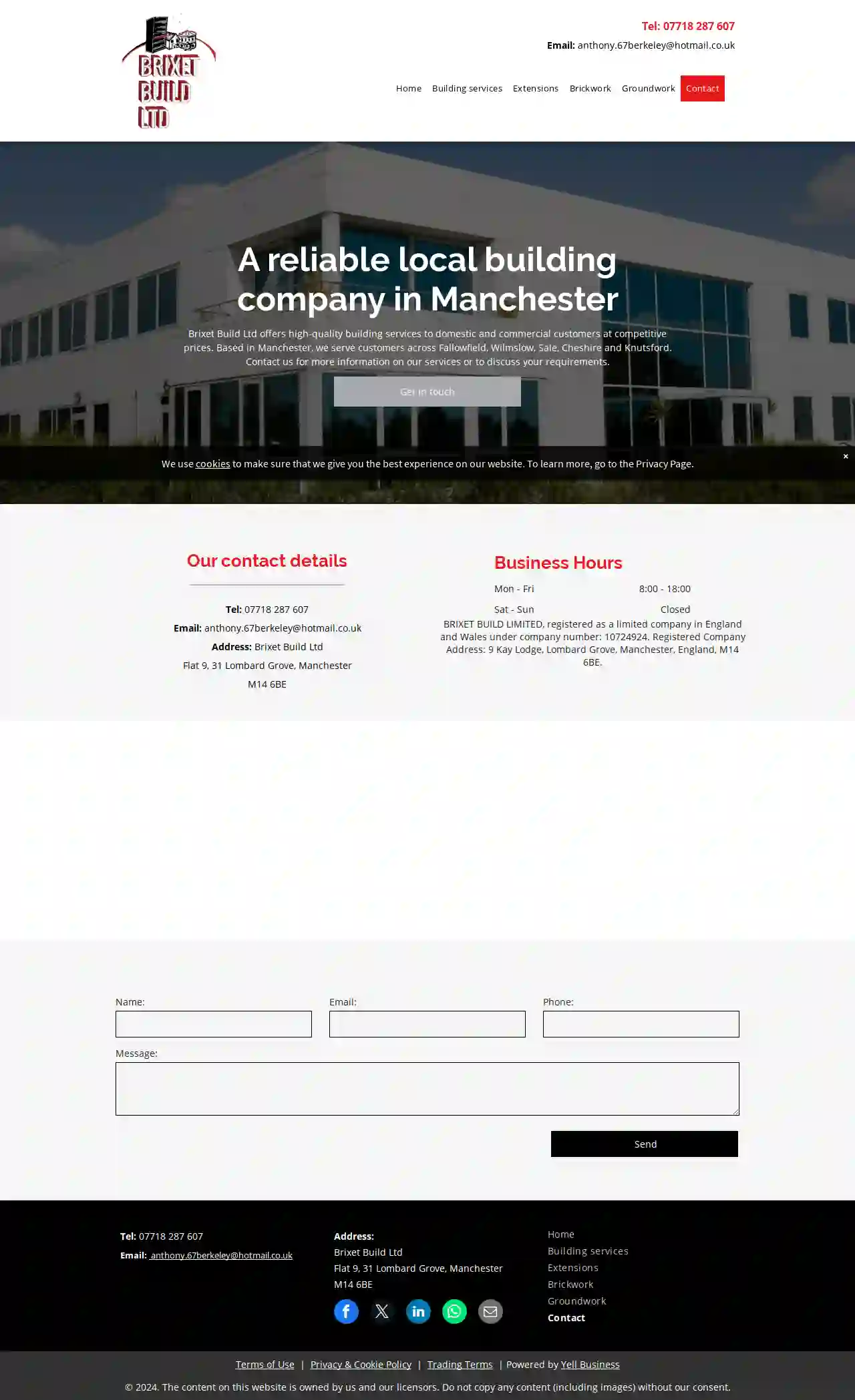Demolition Contractors Heswall
Find top Demolition Contractors in Heswall
Receive up to 3 Demo Contractors quotes for your project today! Compare profiles, reviews, accreditations, portfolio, etc... and choose the best offer.

Metro Rod
Ashwood Court, Tytherington Business Park, Macclesfield, Cheshire, SK10 2XF, GBMetro Rod: Your Trusted Drainage Experts Metro Rod is the UK's leading drainage company, providing professional and reliable services for both businesses and homes. With over 40 locally-based teams across the UK, we offer the most comprehensive drainage solutions, exceptional customer service, and the fastest response times. Whether you're facing a drainage emergency, a recurring problem, or simply need routine maintenance, our team of highly qualified engineers is here to help. We understand that drainage issues can be disruptive and stressful. That's why we're committed to providing a seamless and efficient service, from the initial consultation to the final solution. Our team is equipped with the latest technology and expertise to handle any drainage challenge, no matter how complex or challenging. At Metro Rod, we pride ourselves on our commitment to customer satisfaction. We go the extra mile to ensure that our clients are happy with our work and that their drainage systems are functioning properly. We also offer a range of services to help prevent future problems, such as regular maintenance and inspections.
- Services
- Why Us?
- Accreditations
- Gallery
Get Quote
Boundary Plant Hire Ltd
Hammond Road, Knowsley Industrial Park, Liverpool, L33 7UL, GBPlant Hire Liverpool If you're looking for plant hire in Liverpool, Boundary Plant Hire Ltd is here to help. We specialize in the sale and hiring of excavators, mini diggers, telehandlers, and all types of heavy plant and construction machinery. We're experts in plant hire in Liverpool and have been operating in this industry and area for over 50 years. Our experience and reputation make us the perfect choice if you're looking for a wide range of affordable and reliable plant hire, with or without an operator. We work with a wide range of clients, from other construction companies and contractors to those doing DIY at home or on a smaller scale. Whatever you need, we're here to help. Call our experts to get advice on what machinery is best suited for your project so you can save time and money by utilizing the latest technology that can be used in many different applications. Our experience and service are second to none. We pride ourselves on offering a fair service that is always reliable, prompt, and on time. With our huge selection of vehicles and plant hire in Liverpool, you can be certain you'll find what you need at a price that will save you money and/or effort on your building and construction projects. We're based in Knowsley, Merseyside, right next to the motorway, meaning we can always deliver quickly due to the fantastic road links surrounding our premises. We're very proud to have a huge fleet of plant hire vehicles, including 360 tracked and wheeled excavators that range in size from 1.7 tonnes all the way up to 36 tonnes, complete with trailers. We have JCB 3CX excavators, telehandlers ranging from 7 meters to 20 meters tall, dumpers ranging from 1 tonne to 6 tonnes, and a selection of premium roller vehicles. Our excavators all come with optional attachments such as grapples, munchers, and hydraulic breakers should you require them. Likewise, we also provide fully trained operators for all of our vehicles if you need them. No matter how big or small your project is, we have the perfect vehicle to help ease the load. No matter where you're based, our location allows us to deliver plant hire in Liverpool straight to your door in record time. We offer reliable and rapid delivery as well as a collection service depending on your requirements. We make sure that our service is always world-class and that our vehicles and service are always kept cutting edge. We're constantly evolving, and our vehicles will always represent the latest and greatest, so you can trust us to provide you with only top-quality plant hire in Liverpool and beyond. Contact us at Boundary Plant Hire Ltd today for a no-fuss discussion on your needs and what we can do for you. We guarantee you won't be disappointed.
- Services
- Why Us?
- Gallery
Get Quote
Stanley Coronation Park
436 reviews52 Derby Street, 52 Derby Street‚ Ormskirk‚ Lancashire‚ L39 2DF, Ormskirk, L39 2DF, GBWest Lancashire Borough Council: Serving Our Community West Lancashire Borough Council is dedicated to providing essential services and supporting the well-being of our residents. We strive to create a thriving community where everyone can flourish. Our commitment to excellence is reflected in our diverse range of services, from waste collection and housing to planning and leisure. We are committed to transparency and accountability, ensuring that our decisions are made in the best interests of our residents. We are proud of our history and our role in shaping the future of West Lancashire. We work closely with local businesses, community groups, and residents to address the challenges and opportunities facing our borough. Our team of dedicated professionals is committed to delivering high-quality services and making a positive difference in the lives of our residents.
- Services
- Why Us?
- Gallery
Get Quote
Drain Unblocking, Surveying and Repairs - Mersey Rod
4.9290 reviewsLiverpool, GBMersey Rod: Your Trusted Drainage Experts Mersey Rod is a leading drainage company serving Merseyside, Lancashire, Greater Manchester, Cheshire, and North Wales. We offer a comprehensive range of services, from drain clearance and unblocking to CCTV surveys and drain repairs. Our team of experienced and qualified engineers is dedicated to providing our clients with the highest quality service at competitive prices. Our Commitment to Excellence At Mersey Rod, we are committed to providing our clients with the best possible service. We use the latest technology and equipment to ensure that all our work is carried out to the highest standards. We are also fully accredited and insured, giving you peace of mind that your project is in safe hands. Why Choose Mersey Rod? Experienced and qualified engineers 24/7 emergency service Competitive prices Fully accredited and insured Commitment to customer satisfaction
- Services
- Why Us?
- Accreditations
- Gallery
Get Quote
Creative Landscapes - Landscaping Services Southport
518 reviewsChester, GBCreative Landscapes Southport At Creative Landscapes, we are passionate about turning ordinary outdoor spaces into extraordinary landscapes. We specialize in crafting outdoor environments that are both aesthetically stunning and functionally practical. More About Us We understand that creating your dream landscape is an investment. That's why we offer hassle-free financing options designed to make your vision achievable without breaking the bank. Experience the convenience of expert guidance right at your doorstep. Our complimentary at-home consultations are designed to bring our landscape expertise directly to you. Our dedication to precision and attention to detail sets us apart. With skilled artisans at the helm, we craft landscapes that not only meet but exceed your expectations. Your trust is our priority. We are fully licensed and insured, giving you the confidence that your project is in capable hands with our commitment to safety and professionalism.
- Services
- Why Us?
- Testimonials
- Gallery
Get Quote
Brixet Build Ltd
Flat 9, 31 Lombard Grove, Manchester, M14 6BE, GBAbout us Brixet Build Ltd is a reputable construction company located in Manchester. With over 20 years of experience in building trade, we follow a systematic approach from concept to completion to provide the best service to our clients. We undertake construction work for projects of all sizes. From sewers and drainage to maintenance work and concreting, you can count on us for a complete service. We specialise in extensions but carry out all aspects of building work. To have a detailed discussion with our professionals, get in touch with us and we will be happy to help you. Quality workmanship We are a team of experienced and skilled builders who are committed to providing high-quality workmanship. We use only the best materials and techniques to ensure that your project is completed to the highest standards. 20 years' experience We have over 20 years of experience in the building industry. This means that we have the knowledge and expertise to handle any project, no matter how big or small. Fully insured We are fully insured, so you can rest assured that your project is in safe hands. We are committed to providing our clients with peace of mind.
- Services
- Why Us?
- Gallery
Get Quote
JW Asbestos & Demolition Services Limited
58 reviewsUnit 2B Lansil Industrial Estate, Caton Road, Unit 2B Lansil Industrial Estate Caton Road Lancaster, Lancaster, LA1 3PQ, GBJW Group are your ‘One Stop Shop’ for Demolition, Soft-Strip Demolition and Groundworks Contractors Demolition of a building or structure requires a great deal of care and the support of a specialist demolition company like JW Asbestos and Demolition Lancaster. Depending on the size and position of the structure, whether it contains asbestos or precious metals, whether it is a steel frame or concrete frame, different methods of demolition may be employed. It is important that all operations are done with the highest standards of health and safety. JW Group is an expert demolition contractor covering Lancaster, Lancashire. Cumbria and Dumfries and Galloway and are specialist in Soft Strip Demolition. We have experience of demolition of high-rise buildings, careful dismantling and deconstruction of structures, strip-out works, asbestos removal and concrete crushing. We can also remove underground tanks etc. and ground decontamination on brown field sites. Our demolition, soft-strip demolition, asbestos removal and groundworks will be carried out in accordance with HSE legislation and Guidance. The works will also be carried out in accordance with all procedures within the standard procedures for work. We are fully accredited for all of the works we do and you can rest assured that it will be carried out to the highest possible standards. Services: Demolition Contractors Lancaster Concrete Crossing Underground Tank Removal Demolition of High Rise Building Soft Strip Demolition Building Dismantling Covering Lancaster, Lancashire, Cumbria and Dumfries and Galloway.
- Services
- Why Us?
- Testimonials
- Gallery
Get Quote
Thorncliffe Building Supplies Ltd
4.488 reviewsAlltami, Mold, Ewloe Barn Industrial Estate, Mold Road, Ewloe, CH7 6LG, GBWork, Adventure, Performance From open road to trail exploration, we have a vehicle for you. Your North Wales Dealership View our range
- Services
- Why Us?
- Testimonials
- Gallery
Get Quote
Groundworks Driveways & Patios
58 reviewsWaters Green House, Waters Green, Waters Green HouseWaters GreenMacclesfield, Macclesfield, SK11 6LF, GBAbout Groundworks Driveways & Patios Ltd Groundworks Driveways and Patios Ltd specialise in a wide variety of driveways and block paving work, with many years experience with in the trade. Our experienced and professional staff can offer you free impartial advice on all your block paving driveway requirements. With years of experience in the building field, you can be confident of our quality and reliability. All our work is fully guaranteed and carried out to your total satisfaction. Our Services Groundworks Driveways & Patios offer a full range of traditional colours and designs along with a complete service, with site preparation if necessary. Why Choose Groundworks Driveways? Unbeatable value for Patios, Driveways, Block Paving, Resin Driveways & Landscaping in Macclesfield and the surrounding areas. It’s simple, we don’t have an unnecessary showroom, pushy sales team or cheesy TV adverts, this allows us to keep our overheads low and pass on that saving to you, the customer. At the end of the day all you need and all your looking for is a qualified and experienced paving company to install your new outdoor patio or driveway surface at an unbeatable price, and we are proud to be able to offer the best prices in Macclesfield.
- Services
- Why Us?
- Testimonials
- Gallery
Get Quote
D Morgan
4.319 reviewsNew HeyChester Road, Great SuttonEllesmere Port, New HeyChester RoadGreat SuttonEllesmere Port, Ellesmere Port, CH66 2LS, GBD Morgan plc, a company established in 1950 with a wealth of experience delivering value engineering solutions as Principal Contractor, Alliance Partner and Plant & Transport services. We meet your requirements from conception to completion. Our team consists of knowledgeable, experienced and skilled professionals who innovate to provide the best outcome for you. What we do Major Developments – design, development and construction schemes Civil Engineering – design, construction, and maintenance capabilities Earthworks and Remediation – ground engineering and soil stabilisation Demolition and Recycling – dismantling and maximising recovery potential Plant and Transport – all our own equipment, all our own people Innovation and Technology – industry leaders through investment Our People, Our Culture – investment in our people with strong leadership Land and Property – warehousing and industrial units available for rent Whether you capitalise on our Early Contractor Involvement, or on the shared efficiencies of Alliance Partnering, our full design and engineering programme service assures your project is completed in a cost-efficient manner on time. We have developed over decades 'A Culture of Making Excellence a Habit' with our long-serving people. This is based upon their knowledge, experience and confidence to innovate. D Morgan was established in 1950 by Denis Morgan and is a diverse family-run business with a national reputation. We have a dedicated in-house team of more than 220 people, ranging from Plant Operators through to Project Managers, all committed to delivering the highest standards of service and quality.
- Services
- Why Us?
- Accreditations
- Gallery
Get Quote
Over 13,059+ Excavation Contractors registered
Our excavation companies operate in Heswall and surroundings!
ExcavationHQ has curated and vetted the Best Excavation Contractors in Heswall. Find a trustworthy contractor today.
Frequently Asked Questions About Demolition Contractors
- Implosion: Using explosives to collapse a structure inwards rapidly. Suitable for large buildings in open areas.
- Wrecking Ball: Swinging a large steel ball to impact and break down the structure. Effective for bringing down walls and other solid elements.
- High-Reach Demolition: Utilizing specialized excavators with extended arms and demolition attachments for dismantling tall structures piece by piece.
- Selective Demolition: Removing specific parts of a building while preserving other sections. Often used in renovation projects.
- Deconstruction: Carefully dismantling a building to salvage reusable materials, reducing waste and environmental impact.
- Size and Type of Structure: The method should be suitable for the structure's size, height, and construction materials.
- Site Location and Accessibility: The method should be feasible given the site's location, surrounding buildings, and access constraints.
- Environmental Considerations: Prioritize methods that minimize environmental impact, such as deconstruction or selective demolition if feasible.
- Budget: Different demolition methods have varying costs, so choose one that fits your budget.
- Safety: Prioritize methods that ensure worker safety and minimize risks to surrounding areas.
- General Liability Insurance: Covers bodily injury or property damage to third parties caused by the contractor's negligence.
- Workers' Compensation Insurance: Provides benefits to workers injured on the job.
- Pollution Liability Insurance: Covers costs associated with environmental contamination caused by demolition activities.
- Professional Liability Insurance: Protects against claims of negligence or errors in professional services, such as demolition planning or consulting.
What are the different types of demolition?
What is the difference between demolition and deconstruction?
Demolition: Typically involves bringing down a structure quickly and efficiently, often using heavy machinery and potentially explosives. The primary goal is to clear the site.
Deconstruction: Focuses on carefully dismantling a building piece by piece to salvage reusable materials. It prioritizes minimizing waste and environmental impact, often involving manual labor and specialized tools.
The choice between demolition and deconstruction depends on the project's objectives, budget, and environmental considerations.
How do I choose the right demolition method for my project?
What is the importance of insurance in demolition projects?
What are the different types of demolition?
- Implosion: Using explosives to collapse a structure inwards rapidly. Suitable for large buildings in open areas.
- Wrecking Ball: Swinging a large steel ball to impact and break down the structure. Effective for bringing down walls and other solid elements.
- High-Reach Demolition: Utilizing specialized excavators with extended arms and demolition attachments for dismantling tall structures piece by piece.
- Selective Demolition: Removing specific parts of a building while preserving other sections. Often used in renovation projects.
- Deconstruction: Carefully dismantling a building to salvage reusable materials, reducing waste and environmental impact.
What is the difference between demolition and deconstruction?
Demolition: Typically involves bringing down a structure quickly and efficiently, often using heavy machinery and potentially explosives. The primary goal is to clear the site.
Deconstruction: Focuses on carefully dismantling a building piece by piece to salvage reusable materials. It prioritizes minimizing waste and environmental impact, often involving manual labor and specialized tools.
The choice between demolition and deconstruction depends on the project's objectives, budget, and environmental considerations.
How do I choose the right demolition method for my project?
- Size and Type of Structure: The method should be suitable for the structure's size, height, and construction materials.
- Site Location and Accessibility: The method should be feasible given the site's location, surrounding buildings, and access constraints.
- Environmental Considerations: Prioritize methods that minimize environmental impact, such as deconstruction or selective demolition if feasible.
- Budget: Different demolition methods have varying costs, so choose one that fits your budget.
- Safety: Prioritize methods that ensure worker safety and minimize risks to surrounding areas.
What is the importance of insurance in demolition projects?
- General Liability Insurance: Covers bodily injury or property damage to third parties caused by the contractor's negligence.
- Workers' Compensation Insurance: Provides benefits to workers injured on the job.
- Pollution Liability Insurance: Covers costs associated with environmental contamination caused by demolition activities.
- Professional Liability Insurance: Protects against claims of negligence or errors in professional services, such as demolition planning or consulting.